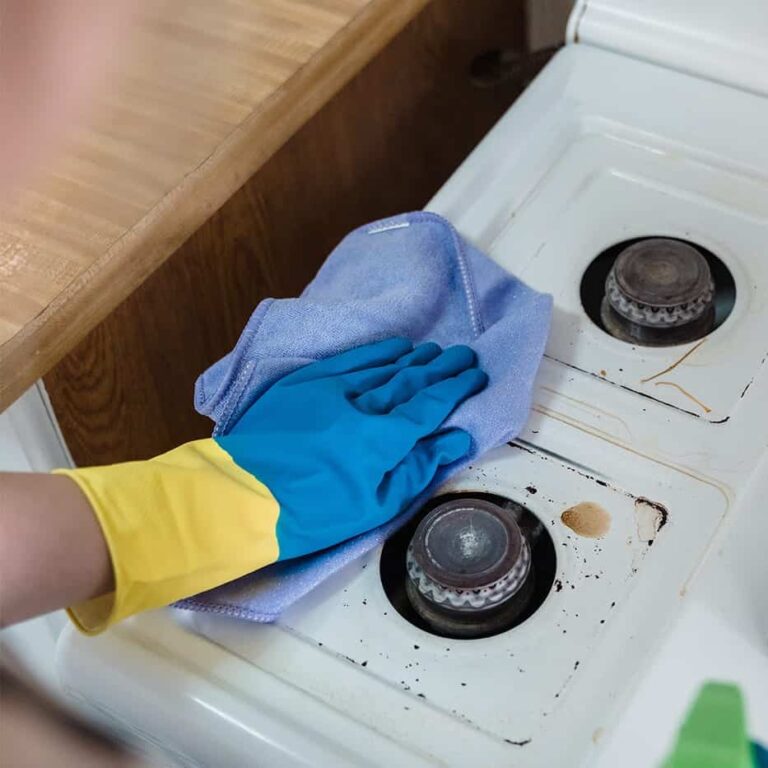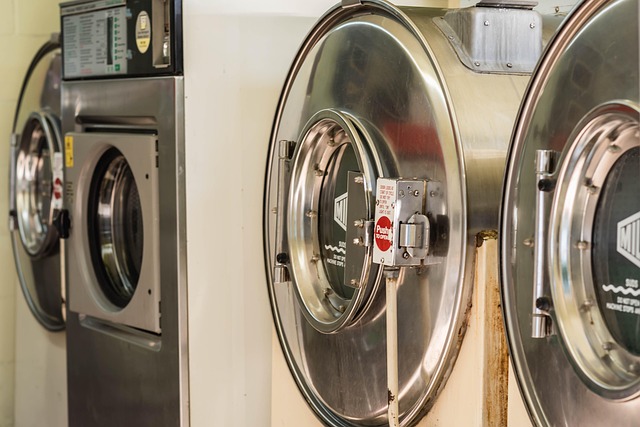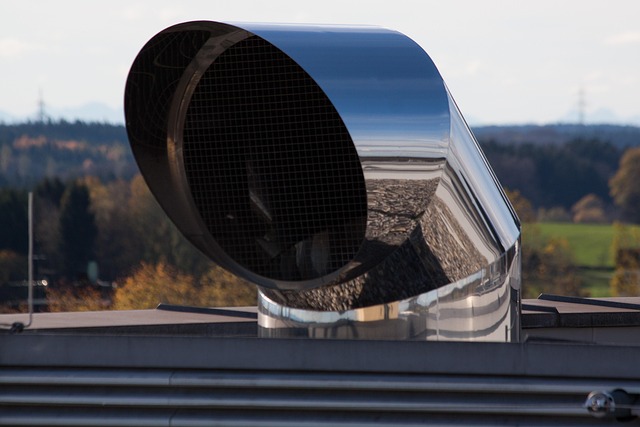Key Takeaways
- If quarterly care is not practical, plan at least one thorough cleaning each year4.
- Make cleaning more or less frequent depending on system type, local climate, your home environment, how often you run your system and its age. Keep track of these variables in a maintenance log to customize schedules for each unit.
- Keep an eye out for blockage indicators like standing water, musty odors, shutdowns, and visible mold. DRY WIRES = HAPPY TECHS Create a simple checklist and act fast to prevent water damage and expensive repairs.
- Minimize clog risks by controlling algae, mold, dust and installation problems. While you’re at it, flush with vinegar solution, pan tablets as directed, replace your filters on time, and check your drain line slope.
- Safeguard health and indoor air quality by controlling biofilm and microbial growth in the drain system. Mix regular DIY flushing with annual professional checkups for full coverage.
- Create a maintenance calendar to schedule quarterly cleanings and seasonal checks. Record dates, results and measures to maintain the drain line free and system efficient.
HVAC drain lines should be cleaned every 6 to 12 months to prevent clogs, algae growth, and water leaks. Drier climates, on the other hand, can likely get away with yearly service.
Trouble signs are musty smell, water around the air handler or a full drain pan. Basic care is a wet/dry vac and mild vinegar flush. How often should HVAC drain lines be cleaned?
How Often to Clean HVAC Drain Lines?
Quarterly cleaning keeps condensate moving and minimizes clogs, odors and overflow. If quarterly is not realistic, schedule one full clean each year, then supplement with quick monthly flushes in peak cooling. Vary by type of system, climate, home conditions, usage, and age.
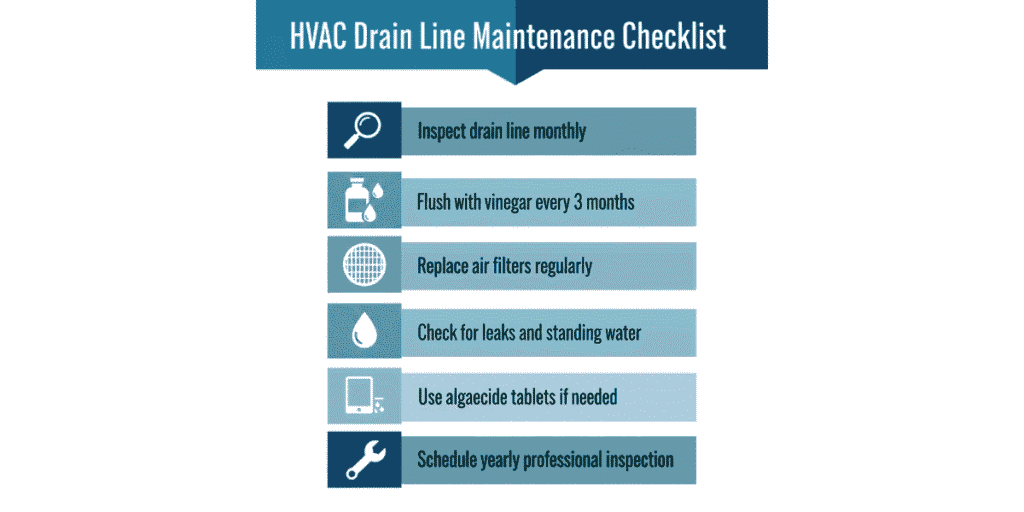
- Baseline: clean every 3 months.
- Minimum: once per year if quarterly isn’t feasible.
- Peak season: flush every 30–60 days. If you pour 1/4 cup distilled white vinegar monthly, it will help keep the algae and mold at bay.
- Skipping cleanings risks water damage, mold, and lower efficiency.
Table: Maintenance Calendar (example)
- January: Inspect trap; note usage
- March: Full clean; log vinegar flush date
- May: Flush; 1/4 cup vinegar
- July: Flush; 1/4 cup vinegar
- September: Full clean; test float switch
- November: Flush; 1/4 cup vinegar
1. System Type
Central ACs can shed more condensate during extended cooling runs, so begin with quarterly cleanings and throw in monthly vinegar in the sunniest months. Heat pumps that heat and cool all year can produce condensate on both modes; flush every 30–60 days in long wet stretches.
Mini-splits have tiny lines that clog quickly with biofilm – check the pan and line monthly in humid seasons, and clean at least quarterly.
Commercial systems with large coils and high airflow create a lot of condensate, so consider monthly inspections and bi‑monthly flushes. Multi-line or gravity-plus-pump setups require individual inspections for each drain. Note unit type, number of drains, and if a pump is in your log to customize schedules.
2. Local Climate
High humidity quickens algae and mold growth. In humid regions, scrub quarterly and flush monthly. Vinegar works great to keep growth at bay.
Check for debris after heavy rain or storms. Dry areas encounter dust and other fine materials that land in traps. Short monthly flushes will keep airflow humming.
It’s important to clean before and after peak cooling, and tailor your schedule to local weather fluctuations.
3. Home Environment
Pets, fabric-laden spaces, or high traffic stir up lint and dust. Clean quarterly, and flush every 30 days during summer.
Bad air circulation or indoor humidity breeds mildew. Use dehumidifiers and swap filters on schedule to reduce load on the drain.
Cigarette smoke or heavy stovetop cooking deposits sticky particles. Air purifiers and MERV-appropriate filters assist in decreasing buildup.
4. Usage Patterns
Long daily runtimes require 30–60 day flushes and quarterly cleans. If the unit dehumidifies the majority of the year, reduce the intervals.
Trace run hours or seasonal bills as a proxy and clean following use spikes.
5. System Age
Older lines roughen inside and hook sludge. Clean more frequently and check for cracks or rusting at each cleaning.
Swap out any brittle vinyl or kinked sections to prevent leaks. Track age and repairs in your log to predict upgrades and define tighter cleaning cycles.
The Risks of Neglect
Neglecting regular ac drain line cleaning introduces the risks of leaks, outages, and increased expenses while increasing indoor air risks and reducing hvac equipment life.
Water Damage
A clogged condensate drain feeds water in the pan, then over the edge. That overflow can discolor ceilings, damage wood floors and saturate walls. During humid seasons the amount accumulates quickly, and drywall absorbs moisture well past the unit.
Tackle leaks and overflows the SAME day! Turn the system off, empty the trap and vacuum the line from the service port. If the pan is rusted or cracked, get a new one before it gives out.
Keep an eye out for water stains, pooling around the air handler, or damp insulation – musty smells generally indicate a gradual clog, from mineral build up or dirt or mold. Add a secondary pan and some float switch that turns it off before the water overflows.
System Failure
Blocked drains can trip safety switches, shutting down to prevent flooding. That translates to lost cooling or heating when it matters most. Excess moisture corrodes electrical parts and can strain the evaporator coil because if condensation freezes on the coil, the compressor’ll overwork when it thaws.
Maintaining the line free of restrictions helps ensure constant airflow and consistent coil temperatures, reducing the risk of short cycling. Inspections catch loose drain fittings, sagging vinyl lines and algae film before they bloom into a blockage.
They bring up associated problems—such as malfunctioning thermostats that lead to erratic cycling and excessive condensate—that increase the risk of a breakdown.
Poor Air Quality
Water sitting in pans, traps, and lines can promote mold growth and mildew, leading to serious indoor air quality issues. The spores and microbial byproducts can catch the air stream, degrading air quality and causing respiratory distress in vulnerable individuals. Airflow restricted by a clogged ac drain or soggy filter exacerbates the problem, as slower air allows moisture to marinate on the evaporator coils. Regular ac maintenance is crucial to keep ducts clean, drain paths clear, and filters swapped on schedule to minimize moisture pockets.
To tackle the issue, try drain line cleaning treatments rated for HVAC use, and flush the condensate drain line with clean water to move out debris effectively. If you smell odd odors around the indoor unit, investigate for standing water or slime in the trap and address it before mold buildup occurs or growth extends.
Implementing a routine air conditioning maintenance schedule can help prevent these issues. Additionally, using a diluted algaecide in the condensate drain can effectively combat algae growth and ensure that the air conditioning system runs smoothly. Always check for any clogs in the ac drain line to maintain optimal performance of your HVAC equipment.
Higher Costs
Water restoration and mold cleanup emergency calls are so much more costly than regular clean energy waste.
Waste soars when bad drainage causes extended run times and uneven temperatures, showing up as increased utility bills. Forgotten blockages — typically from dirt, mineral scale or mold — may harm components, while overlooked units increase safety concerns, such as electrical shorts or fire risks from corroded parts.
Regular inspections identify minor damages before it’s too late, maintain optimal flow and prolong operational life — delaying costly boiler swaps.
Identify Blockage Warning Signs
Early signs of a clogged ac drain line predict potential water damage and downtime for your air conditioning system. Train everyone in the house or office on what to watch for and maintain an easy checklist for routine air conditioning maintenance.
Standing Water
Standing water – that’s the most obvious red flag. Check inside the drain pan and around the indoor air handler for standing water or wet floors. Even a slight film that reappears after cleaning suggests a sluggish clog.
If moisture appears on adjacent walls or beneath the HVAC cabinet with no other explanation, suspect the drain line. In humid climates, minor leaks become streaks and swollen trim in no time.
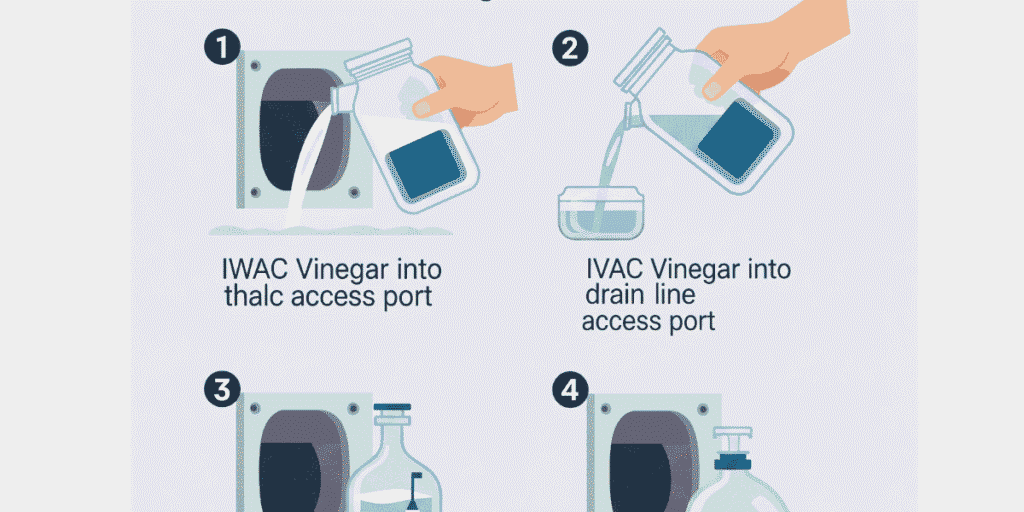
Try a wet vac at the drain outlet to suck out water and gunk. Then pour a 1:1 water–vinegar mix into the line, let it sit at least 30 minutes, and flush to clear algae or sludge.
Keep a log of date, location and size of puddles to identify trends and time cleanings to every 3 to 6 months.
Musty Odors
Musty or moldy smells from vents or near the unit frequently indicate stagnant water in the pan or line. Mold loves damp air and a clogged line provides it a home.
Scrub down the line and pan, then flush a vinegar solution through the drain to kill growth. Change or clean filters to prevent re-circulating smell – target fresh filters at a minimum of every 12 weeks.
If odors persist, flush again and check the trap for slime.
System Shutdowns
Abrupt halts may indicate a filled drain pan activating a float switch. That switch safeguards the air handler against overflow and possible electrical damage.
Don’t just reboot. First check the line is clear, the pan drained and the float moves freely. Record shutdown date, runtime prior to trip, and any error codes to assist a technician in identifying patterns.
If shutdowns return despite routine cleaning, schedule service and ask for a complete condensate path check–during seasonal maintenance.
Visible Mold
Notice mold on the pan edge, drain tube, insulation or the cabinet base? Address it heedfully as a moisture and drainage concern, not merely a cleanliness matter.
Mold by the line can frequently indicate residual water from a partial clog. Clean with diluted vinegar or a reputable commercial product, according to label instructions.
Gloves and a mask – who needs spores? Finish by flushing the drain and setting a preventive cadence: clean the line every three to six months, replace filters on time, and include condensate checks in regular professional maintenance.
This minimizes the threat of water damage, insufficient cooling, and failures.
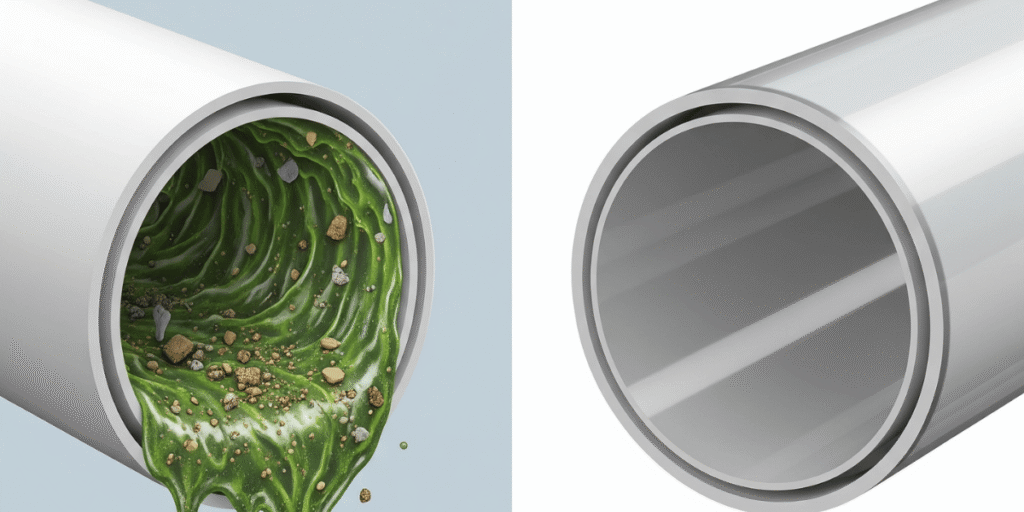
What Causes Drain Line Clogs?
Condensate drain lines often fail when water flow stagnates, allowing gunk to adhere. The typical culprits include dirt, mold, and algae growth that collect in constricted parts of the ac condensate drain line. Most houses experience this at some time or another, as bacteria and fine dirt are almost everywhere.
- Microbial growth: mold, algae, and bacteria
- Dust, lint, and construction debris
- Stagnant water from poor slope or sags
- Corrosion or degraded materials
- Long horizontal runs and sharp bends that trap sludge
Algae and Mold
The warm, moist environment inside the drain pan and tubing is a perfect breeding ground. Biofilms develop on pipe walls, which then capture grit and lint, which then becomes a sludgy plug. The same algae mats that you encounter in ponds or deep‑standing puddles can manifest themselves in a drain line.
Over time, these mats and mold threads constrict the passage until water backs up and activates a float switch. Flushing the line with plain white vinegar or an approved HVAC cleaner helps break down organic buildup. Some people dose monthly in peak cooling season, since frequent moisture feeds growth.
In spaces with high humidity or near gardens and water features, UV lights at the coil or algaecide tablets in the pan can slow regrowth. Check for green or black residue in the pan, a sour smell, or slow drip at the outlet. Those are telltale signals biofilm is alive and well and hungry.
Dust and Debris
Airborne dust, pet hair and lint surf the air stream, land in the pan and rinse into the line. So dirt and other particles then cling to biofilm, creating sludge that clogs over time. Dirt is a usual suspect, particularly in houses with open windows or lots of visitors.
Maintain clean, properly-sized filters and seal duct leaks so less dust escapes filtration. Vacuum around the air handler and intake vents to trim back loose grit. Drain the condensate line periodically to flush out silt before it compacts.
If you have building work nearby, cover returns and air handler, and plan on flushing more often from elevated airborne load.
Installation Issues
Drain lines require a consistent downward slope of approximately 10–20 mm per metre, safe joints and a trap where necessary to keep good airflow. Sharp bends, long flat runs and low spots retain water, which cultivates algae and allows dirt to settle.
Go with PVC or another approved, non-corrosive material that remains smooth inside and resists breakdown. Following any new install or coil replacement, schedule a professional inspection to confirm proper pitch, appropriate trap sizing and unobstructed discharge, as minor construction oversights can fuel recurring blockages.
The Unseen Ecosystem in Your Drain Line
Biofilms, bacteria, mold, and algae mats like in ponds thrive on condensate drain lines. This living slurry shifts flow, captures detritus, and can aerosolize particles into indoor air. When left unchecked, it decreases efficiency and increases health hazards.
| Microorganism | Where it thrives | What it does | Impact on drain health |
|---|---|---|---|
| Algae | Sunlit or warm, stagnant condensate | Forms mats | Slows flow, seeds clogs |
| Bacteria | Nutrient film on pipe walls | Builds biofilm matrix | Shields other microbes |
| Mold | Moist, shaded surfaces | Releases spores | Odors, irritation, blockage |
| Fungi yeasts | Residual sugars/organics | Competes with bacteria | Shifts pH, sludge |
| Actinomycetes | Damp dust deposits | Produces earthy smell | Sticky residue |
Managing this biological activity helps maintain consistent drainage, keeps coils drier, and air fresher.
The Biofilm
Biofilm is a slimy, sticky film that develops along the inner wall of the condensate line. It catches dust, rust, and lint, then congeals into a mat that restrains or obstructs flow. For most homes, it’s the source of the repeat clogs and overflow pans filling up.
Regular flushing disrupts that cycle. Flush at least two cups of clean water through the line, then a water-vinegar mixture (¼ to ½ cup). Let sit for 30-45 minutes, then flush again with water to clear loosened film and fines.
Biofilm protects mold and pathogenic bacteria from light rinses. That cover allows them to bounce back rapidly after a quick clean. For stubborn buildup, plan a deep clean: wet vac on the outlet, brush-safe access at the trap, or a professional service that can sanitize the pan, trap, and line.
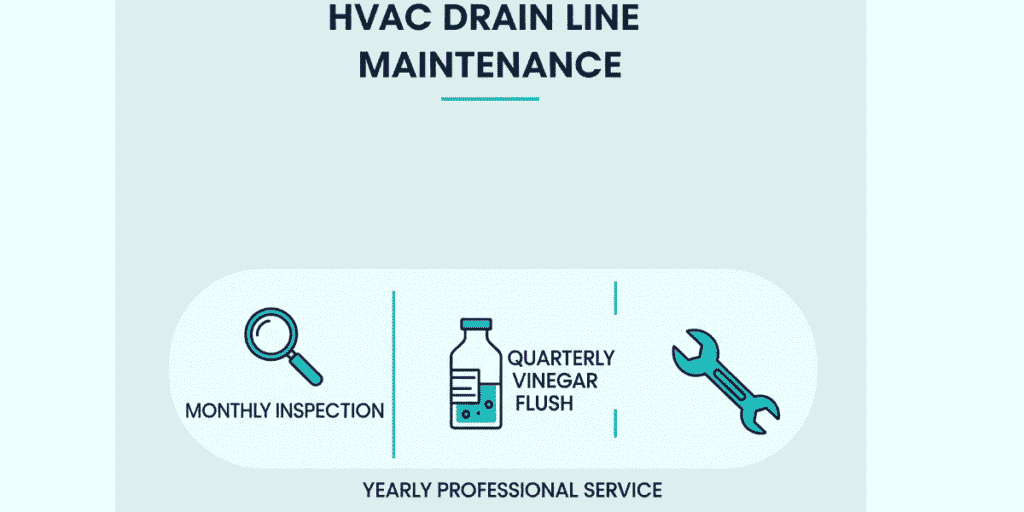
Airborne Spores
Mold spores and bacteria hitch a ride with return air and colonize in places where that condensate remains moist. A silent elbow of the line is sufficient acreage for expansion.
Good filters designed for fine particles scrub spores before they can get to the coil and pan. Change on time, and install the filter properly to prevent bypass.
TAKE CONTROL OF INDOOR HUMIDITY TO REDUCE SPORE GROWTH. Proper ventilation and consistently moderate humidity restrict the moisture film required by spores.
Flush the drain line, but flush the coil, flush the pan, flush the trap. If the pan harbors slime, the line will re-seed.
The Health Impact
If left uncontrolled, the microbes can spread allergens, odors, and toxins into the air that circulates. Sensitive folks might detect problems early, but anyone can experience symptoms in an enclosed environment.
Clog on clog on fix clogs fast. Surplus water surrounding the air handler is an obvious indicator the line requires cleaning, and standing condensate pumps microbes into the air stream.
Routine HVAC maintenance keeps your system running efficiently and your home healthier. In areas where clogs are prevalent, monthly inspections during peak cooling count.
Provide easy maintenance tips to all residents so maintenance remains uniform.
How to Maintain HVAC Drain Lines Effectively?
A clear condensate drain line keeps water moving, prevents clogged ac drain issues, and safeguards your indoor air. Pair routine air conditioning maintenance with seasonal pro cleaning for consistent performance in any weather.
- Shut power off at the breaker and find the drain line cleanout proximate to the air handler. Observe pipe material and path to design secure cleaning.
- Look for standing water, rust, slime or cracks in the drain pan. Scrape out gunk with your hand and mop the pan with a rag.
- Flush the line: pour 60–250 ml of white vinegar (about 1/4–1 cup) into the cleanout every 30–60 days in cooling season. Let it sit 20-30 minutes, then warm water follow. Skip the bleach—it can pit metals, deteriorate plastics, and emit fumes.
- Wet/dry vacuum the outside drain outlet for 1-2 minutes to pull sludge then rinse again with hot water. If flow remains weak, repeat or escalate to a pro.
- Add pan tablets per label as a supplement, not replacement and check flow at outlet following treatment.
- Check for correct slope and tight connections. Check for kinks, sagging sections or joints that weep when flow.
- Record the date, actions taken, observations on water color, smell, suction duration, and any alarms triggered. It helps identify trends and prevent overlooked processes.
- Schedule yearly HVAC service to pressure-test, scrub coils and check condensate performance. If the DIY steps don’t do it, stop and call to avoid water damage.
Routine Flushing
Flush monthly during heavy cooling to keep algae and silt in check. A little white vinegar and water — a great solution for most homes. It’s gentle on PVC and copper. Let it stand to dissolve slime, then flush with hot water to transport loosened debris.
Vacuum the drain outlet with a shop vacuum when you notice slow drip, gurgle sounds or pan overflow. A quick vacuum pull usually removes clumps that soaking can’t reach.
Hot water assists as well. Not boiling, just hot from the faucet. It dissipates biofilm but will not bend PVC. Avoid bleach. It can corrode metals, degrade rubber gaskets, and introduce hazardous fumes into your home.
Tablet Usage
Drop algaecide or pan tablets into the condensate pan as instructed to stall growth in hot, muggy months. Pair tablet size with pan volume to prevent build-up. Tablets are to assist routine flushing, not to substitute it.
If clogs persist, record brand, dose and timing, then rotate products or decrease dose. Tablets that dissolve too quickly can leave sludge.
Professional Checks
Schedule an annual inspection to check line condition, pan integrity, float switches and pump operation if equipped. Request a drain clean with vacuum and pressure rinse. Have the tech verify slope (constant fall to the outlet), robust hangers, tight unions and a clean trap with an appropriate vent.
Review the report and update your plan: adjust flush frequency, change tablet type, or fix slope errors to stop repeat blockages and leaks.
Conclusion
Clean drain lines keep everything safe, dry, and steady. A quick rinse each month does. A deep clean twice a year locks in results. Small steps prevent leaks, mold and odors. Clear traps, steady flow and dry pans are all signs of a happy line.
Notice strange noises, musty smell or water around the unit? Act fast. A cup of white vinegar will clear light slime. A wet vac can suck out a clog at the outside opening. For thick gunk or repeat clogs, schedule a professional. That sparing of parts saves energy over time.
To be proactive, make a easy schedule. Mark your calendar, stock basic tools, and log fixes. Need a checklist or a quick guide? Just call and inquire.
Frequently Asked Questions
How often should HVAC drain lines be cleaned?
To prevent algae buildup and clogged AC drain lines, clean the condensate drain line every 3 to 6 months. In humid climates or with heavy usage, check monthly and schedule service with a professional at least once a year.
What are the signs my HVAC drain line is clogged?
Watch for water around the air handler, musty odors, decreased cooling, or the system turning off, as these are signs of a clogged ac drain line or condensate drain issues.
What causes HVAC drain line clogs?
Typical culprits for clogged ac drain lines are algae, mold, dust, and debris combining with condensation. Kinked or poorly sloped pipes and rust from the condensate drain can cause blockages.
How do I clean the drain line myself?
Turn off power to the air conditioning system. Locate the access tee in the condensate drain line. Pour 120–240 mL of distilled white vinegar into the line, then flush with warm water after 30 minutes to ensure proper drain line cleaning and prevent clogged ac drain issues.
Is bleach or vinegar better for cleaning the drain line?
Try using distilled white vinegar as a cleaning solution for your air conditioning system. It’s powerful against biofilm and gentler on components compared to bleach, which can corrode metals and rubber over time.
Can neglecting the drain line damage my HVAC system?
Yes, clogged AC drain lines may lead to water leaks, corrosion, mold growth, or system shutdowns, reducing your indoor air quality and increasing repair costs.
How can I prevent future clogs?
Install a cleanable trap, put in an access tee, and treat monthly with a diluted algaecide solution. Change the air filter regularly and maintain the ac drain line clear with proper pipe slope. Schedule routine air conditioning maintenance annually.



